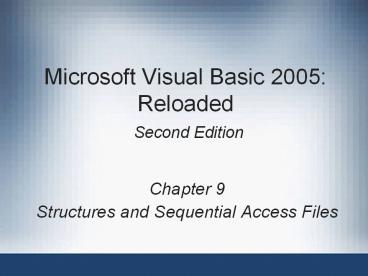Microsoft Visual Basic 2005: Reloaded Second Edition PowerPoint PPT Presentation
1 / 30
Title: Microsoft Visual Basic 2005: Reloaded Second Edition
1
Microsoft Visual Basic 2005 Reloaded Second
Edition
- Chapter 9
- Structures and Sequential Access Files
2
Structures
- Structure statement creates your own data type
- User-defined data type (or structure) data types
created by using the Structure statement - Member variables variables defined within a
structure - Structure can include member variables of
- Any of the standard data types
- Other structure types
3
Structures (continued)
4
Using a Structure to Declare a Variable
- Structure variables variables declared using a
structure - Refer to an entire structure in code using its
name - Refer to a member variable using the structure
name with the dot operator and the member
variable name - Member variables can be used like any other
variables - Structures are used to group related items into
one unit
5
Using a Structure to Declare a Variable
(continued)
6
Using a Structure to Declare a Variable
(continued)
7
Passing a Structure Variable to a Procedure
Open the Pool program and Flow Chart
8
Passing a Structure Variable to a Procedure
(continued)
- Sample application using a structure
- Less code to pass a structure variable to a
procedure - Stores all of the data in a single unit
9
Creating an Array of Structure Variables
- Use a one-dimensional array of structure
variables instead of two-dimensional or parallel
one-dimensional arrays - Refer to a member variable in an array element
by - arrayname(subscript).memberVariableName
10
Creating an Array of Structure Variables
(continued)
11
Creating an Array of Structure Variables
(continued)
12
Creating an Array of Structure Variables
(continued)
13
Creating an Array of Structure Variables
(continued)
14
File Types
- Reading a file getting information from a file
- Writing to a file sending information to a file
- Output files files to which information is
written - Input files files that are read by the computer
- Three types of files in Visual Basic
- Sequential
- Random
- Binary
15
File Types (continued)
- Sequential file data is accessed sequentially,
in consecutive order from the beginning to the
end - Random file data can be accessed in consecutive
or random order - Binary file data is accessed by its byte
location in the file
16
Sequential Access Files
- Sequential access file often called a text file
because it is composed of lines of text - Data must be read sequentially from beginning to
end
17
Sequential Access Files (continued)
18
Writing Information to a Sequential Access File
- WriteAllText method
- Writes information to a sequential access file
- File argument contains the name of the file to
be used - Text argument contains the data to be written
- Append argument if True, data is added to end of
existing file otherwise all existing data is
erased
19
Writing Information to a Sequential Access File
(continued)
- My feature exposes a set of commonly used
objects to the programmer - My.Computer object allows access to objects and
methods to manipulate files - Computer uses a file pointer to trace where the
next character will be read from or written to a
file - Strings.Space method writes a specific number of
spaces to a file
20
Writing Information to a Sequential Access File
(continued)
21
Aligning Columns of Information in a Sequential
Access File
- PadLeft, PadRight methods
- Pads a string with a specified number of
characters based on current length of the string
being padded - Aligns columns of information written to a
sequential access file - Aligns columns of numeric information by the
decimal point
22
Aligning Columns of Information in a Sequential
Access File (continued)
23
Aligning Columns of Information in a Sequential
Access File (continued)
24
Reading Information from a Sequential Access File
- ReadAllText method reads information stored in a
sequential access file - File argument contains the name of the
sequential access file
25
Reading Information from a Sequential Access File
(continued)
26
Determining Whether a File Exists
- An attempt to read a file that does not exist
will cause an error - FileExists method determines if the file exists
before attempting to read it - File argument contains the name of the file
27
Determining Whether a File Exists (continued)
28
The FormClosing Event
- FormClosing event
- Occurs when a form is about to be closed by the
program code or by the user - Allows you to trap the closing action and take
any necessary actions such as saving data - Can be used to cancel the close action
- Set e.Cancel True to cancel the closing action
29
The FormClosing Event (continued)
30
The Friends Application

